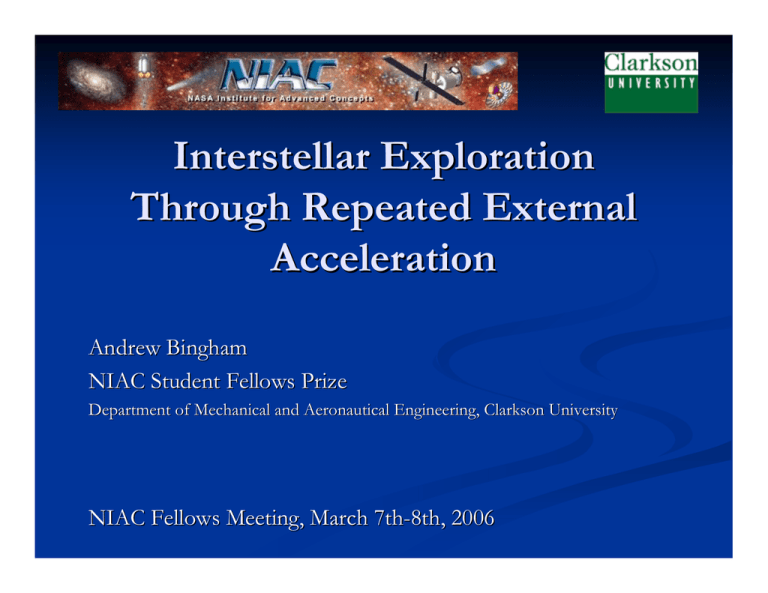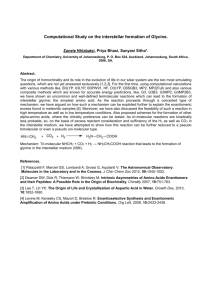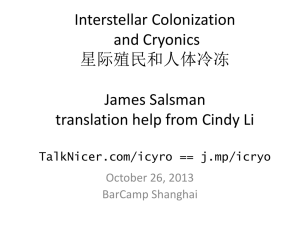Interstellar Exploration Through Repeated External Acceleration Andrew Bingham
advertisement

Interstellar Exploration Through Repeated External Acceleration Andrew Bingham NIAC Student Fellows Prize Department of Mechanical and Aeronautical Engineering, Clarkson University NIAC Fellows Meeting, March 7th-8th, 2006 Agenda Introduction/Background Repeated External Acceleration Concept Current Study Future Work Acknowledgements/References The Heliosphere Current Missions •Voyager 1 & 2 •Pluto New Horizons •Launched in 1977 •Launched December 2005 •Extended Interstellar mission •Passing Termination Shock •Extended mission to visit Kuiper Belt Objects •Communications until 2020 and approximately 120 AU •Communications until 2020 and approximately 50 AU Future Scientific Objectives Investigate physical properties and composition of local interstellar medium for comparison to solar system and galactic abundance. Measure cosmic ray nuclei and electrons without the interference of the heliosphere. Gather data on astrophysical processes such as acceleration by supernova shockwaves, interstellar radio and x-ray emissions, nucleosynthesis, and the dynamics of interstellar medium. Perform direct measurements of the size and structure of the heliosphere. Agenda Introduction/Background Repeated External Acceleration Concept Current Study Future Work Acknowledgements/References Repeated External Acceleration Acceleration stations external to the spacecraft provide primary propulsion. Stations are positioned throughout the solar system. Form a ‘solar system sized slingshot’ Repeated External Acceleration Architecture is reusable and expandable. Stations can carry out other functions in-situ. Major issues include trajectory planning, station and probe hardware configurations Agenda Introduction/Background Repeated External Acceleration Concept Current Study Trajectory Analysis Station Configuration Probe Configuration Future Work Acknowledgements/References Trajectory Analysis Critical Trajectory Features Reach 200AU in 10-15 years Exit heliosphere in direction of bow shock Problem Space Simplification No station at Mars due to small gravity assist available Stations at multiple outer planets avoided due to long orbital periods Two main cases Single station in Earth orbit Dual stations in Earth and Jupiter orbits Basic Calculations Based on travel to 200AU in 15 years: Single station at Earth requires Vinf = 63.2 km/s Delta Vinf at Jupiter vs Delta Vinf at Earth, 200AU in 15 years 400 350 Delta Vinf Jupiter 300 250 200 150 100 50 0 10 20 30 40 Delta Vinf Earth 50 60 Dual 40 km/s stations at Earth & Jupiter 70 Requested Software SNAP – NASA Glenn MIDAS – Jet Propulsion Laboratory Spacecraft N-Body Analysis Program Propagates using 8th order Runge-Kutta Fehlberg routine Patched conic trajectory optimization program Capable of automatically varying, adding, deleting mission phases Satellite Toolkit Industry standard trajectory planning tool SNAP SNAP runs in Linux and other UNIX/BSD environments. Input and output are in the form of formatted text. Fortran source code is available for custom applications. Does not perform optimization. SNAP Input files for the two cases of station configuration are being created. Case 1 – Single station in LEO Case 2 – Dual stations in LEO and Jupiter orbits Station accelerations currently modeled as impulsive. Further Optimization By wrapping an optimization code around SNAP, more efficient trajectories can be found. Currently, a simple optimizer is being written using GNU/Octave. Capable of varying parameters within the representative input files and comparing resulting output for mission success based on critical trajectory limitations. Station Configuration Linear Accelerator MagBeam Tether MagBeam Station Selected Scaleable system. Does not require large space structure. Longer interaction times reduce spacecraft loading. Hardware currently being demonstrated. Probe Configuration Pluto New Horizons spacecraft shares many characteristics with interstellar probes. Long-duration deep space mission. Mass minimized (~500kg) to achieve high velocity. Some instruments designed to measure plasma and solar wind interactions. Further reducing the payload mass through miniaturization could allow the use of a PNHderived spacecraft for an externally accelerated mission to bow shock. Instruments: Probe Payload •Magnetometer •Plasma and Radio Wave Sensor •Solar Wind/Interstellar Plasma/Electron Spectrometer •Pickup and Interstellar Ion Isotope Spectrometer •Interstellar Neutral Atom Spectrometer •Suprathermal Ion/Electron Sensor •Cosmic Ray H, He, Electron, Positron, Gamma-Ray Burst Instrument •Anomalous & Galactic Cosmic Ray Isotope Spectrometer •Dust Composition Instrument •Infrared Instrument •Energetic Neutral Atom (ENA) Imager •UV Photometer Resource Requirements: •Power – 20W •Communications – 25bps •Mass – 25kg Technology Readiness Architecture Component TRL MagBeam System TRL 4 Space Nuclear Power Supply TRL 6 Autonomous Rendezvous TRL 9 Advanced Deep Space Vehicle TRL 9 Miniaturized Instrument Suite TRL 3 Agenda Introduction/Background Repeated External Acceleration Concept Current Study Future Work/Outreach Acknowledgements/References Continuing Work & Outreach Complete trajectory analysis Potential Case 3 – LEO + Mars Stations Publish Web Site Present at AIAA Region I-NE Student Conference, March 30th-April 1st Present at Clarkson University Symposium for Undergraduate Research, April 7th Final Report Agenda Introduction/Background Repeated External Acceleration Concept Current Study Future Work/Outreach Acknowledgements/References Acknowledgements NIAC, for providing the resources to continue working on this project. Dr. Kenneth Visser, for advising me throughout the process. NASA Glenn for providing SNAP. AGI for providing STK. Family, friends, and everyone else who supported me throughout the last year. References Analytical Graphics, Inc, Satellite Toolkit, v.6.2. Hoyt, et. al, A Modular Momentum-Exchange/Electrodynamic-Reboost Tether System Architecture, AIAA-2003-2514. Interstellar Boundary Explorer Science Strategy. http://www.ibex.swri.edu/mission/strategy.shtml Martini, Michael. Spacecraft N-Body Analysis Program 2.3 Users Guide. Analex Corperation, NASA Glenn Research Center, 2005. Mewaldt, R. A., and Liewar, P. C., An Interstellar Probe Mission to the Boundaries of the Heliosphere and Nearby Interstellar Space, NASA Jet Propulsion Laboratory, 1999. Pluto New Horizons Science Payload, http://pluto.jhuapl.edu/spacecraft/sciencePay.html Riehl, Phil. Tools Used By Analysis & Integration Group – MIDAS. http://trajectory.grc.nasa.gov/tools/midas.shtml Vallado, David A, Fundamentals of Astrodynamics and Applications, Microcosm, 2001. Winglee, et. al, Magnetized Beam Propulsion, NIAC Fellows Meeting 2005. Questions?



